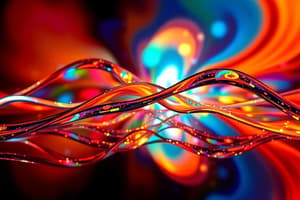Podcast
Questions and Answers
What is the relationship between the speed of light, wavelength, and frequency?
What is the relationship between the speed of light, wavelength, and frequency?
- The speed of light equals wavelength times frequency. (correct)
- Wavelength is independent of the speed of light.
- The speed of light increases with higher wavelength.
- Frequency is proportional to the speed of light and wavelength.
Which phenomenon involves the bending of light when it passes from one medium to another?
Which phenomenon involves the bending of light when it passes from one medium to another?
- Reflection
- Refraction (correct)
- Diffraction
- Polarization
Which of the following describes the separation of light into a spectrum of colors?
Which of the following describes the separation of light into a spectrum of colors?
- Reflection
- Interference
- Diffraction
- Dispersion (correct)
How does polarization of light occur?
How does polarization of light occur?
What does the angle of incidence equal in the law of reflection?
What does the angle of incidence equal in the law of reflection?
Which type of light wave behavior is responsible for creating patterns in the double-slit experiment?
Which type of light wave behavior is responsible for creating patterns in the double-slit experiment?
What defines the color of an object as it relates to light?
What defines the color of an object as it relates to light?
What happens to the speed of light when it passes through a medium like glass?
What happens to the speed of light when it passes through a medium like glass?
Flashcards are hidden until you start studying
Study Notes
Properties of Light
-
Nature of Light
- Light is an electromagnetic radiation detectable by the human eye.
- It travels in straight lines and can be modeled as both a wave and a particle (wave-particle duality).
-
Speed of Light
- The speed of light in a vacuum is approximately 299,792 kilometers per second (km/s).
- It slows down when passing through different media (e.g., water, glass).
-
Wavelength and Frequency
- Wavelength is the distance between successive crests of a wave, usually measured in nanometers (nm).
- Frequency is the number of waves that pass a point in one second, measured in hertz (Hz).
- The speed of light (c) is the product of wavelength (λ) and frequency (ν): c = λν.
-
Reflection
- Light bounces off surfaces according to the law of reflection: the angle of incidence equals the angle of reflection.
- Mirrors and shiny surfaces exhibit this behavior.
-
Refraction
- Bending of light as it passes from one medium to another due to a change in speed.
- Described by Snell's law: n1 sin(θ1) = n2 sin(θ2), where n is the refractive index.
-
Diffraction
- The bending and spreading of light waves around obstacles and openings.
- More pronounced when the size of the obstacle or aperture is comparable to the wavelength of light.
-
Interference
- The interaction of multiple light waves can lead to constructive (amplifying) and destructive (diminishing) interference patterns.
- Commonly observed in experiments like the double-slit experiment.
-
Polarization
- Light waves vibrate in particular orientations; polarized light has waves aligned in a specific direction.
- Can be achieved through reflection, refraction, or the use of polarizing filters.
-
Dispersion
- The separation of light into its component colors due to varying degrees of refraction.
- Commonly observed in prisms, where white light splits into a spectrum of colors.
-
Intensity and Brightness
- Light intensity is related to the power per unit area; perceived brightness depends on the human eye's sensitivity and the light source's properties.
-
Color
- Color is determined by the wavelength of light; the visible spectrum ranges from approximately 400 nm (violet) to 700 nm (red).
- Objects appear different colors based on the wavelengths they reflect, absorb, or transmit.
Nature of Light
- Electromagnetic radiation that can be detected by the human eye.
- Exhibits wave-particle duality, behaving both as a wave and a particle.
Speed of Light
- Approximately 299,792 km/s in a vacuum.
- Slows down when entering denser mediums like water or glass.
Wavelength and Frequency
- Wavelength (λ) is the distance between wave crests, generally measured in nanometers (nm).
- Frequency (ν) represents how many waves pass a point in one second, measured in hertz (Hz).
- The relationship is defined by the equation: c = λν.
Reflection
- Light reflects off surfaces where the angle of incidence equals the angle of reflection.
- This behavior is evident in mirrors and shiny surfaces.
Refraction
- Occurs when light bends as it transitions between different media, changing speed.
- Governed by Snell's law: n1 sin(θ1) = n2 sin(θ2), where n is the refractive index.
Diffraction
- Involves the bending and spreading of light waves around obstacles and through openings.
- More obvious when the obstacle or opening size is close to the wavelength of light.
Interference
- Results from the interaction of multiple light waves creating patterns of constructive (amplifying) and destructive (diminishing) interference.
- Widely demonstrated in experiments such as the double-slit experiment.
Polarization
- Describes light waves vibrating in specific orientations, with polarized light having aligned waves.
- Can be achieved through reflection, refraction, or the use of polarizing filters.
Dispersion
- The process where light splits into various colors due to different degrees of refraction.
- Commonly observed when white light passes through a prism, creating a spectrum.
Intensity and Brightness
- Light intensity measures power per unit area; perceived brightness is affected by the eye's sensitivity and the characteristics of the light source.
Color
- Color perception is tied to wavelength, with the visible spectrum ranging from approximately 400 nm (violet) to 700 nm (red).
- Objects' colors appear different based on the wavelengths they reflect, absorb, or transmit.
Studying That Suits You
Use AI to generate personalized quizzes and flashcards to suit your learning preferences.




